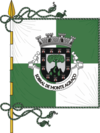Sobral de Monte Agraço Municipality
| Sobral de Monte Agraço | |||
|---|---|---|---|
| Municipality | |||
|
|||
 |
|||
| Coordinates: 39°01′N 9°09′W / 39.017°N 9.150°WCoordinates: 39°01′N 9°09′W / 39.017°N 9.150°W | |||
| Country |
|
||
| Region | Centro | ||
| Subregion | Oeste | ||
| Intermunic. comm. | Oeste | ||
| District | Lisbon | ||
| Parishes | 3 | ||
| Government | |||
| • President | António Bogalho (CDU) | ||
| Area | |||
| • Total | 52.10 km2 (20.12 sq mi) | ||
| Population (2011) | |||
| • Total | 10,156 | ||
| • Density | 190/km2 (500/sq mi) | ||
| Time zone | WET/WEST (UTC+0/+1) | ||
| Website | http://www.cm-sobral-monte-agraco.pt | ||
Sobral de Monte Agraço (Portuguese pronunciation: [suˈβɾaɫ dɨ ˈmõt(ɨ) ɐˈɣɾasu]) is a municipality in the District of Lisbon in Portugal. The population in 2011 was 10,156, in an area of 52.10 km².
The present Mayor is António Lopes Bogalho, elected by the Unitarian Democratic Coalition.
During the Peninsular War, Sobral was on the Lines of Torres Vedras, a line of forts planned by the Duke of Wellington to protect Lisbon. In October 1810, a French army led by André Masséna approached the Lines, finding that the Portuguese had subjected the area in front of them to a scorched earth policy. After the minor Battle of Sobral on 14 October, the French found they could go no further. Charles Oman writes "On that misty October 14th morning, at Sobral, the Napoleonic tide attained its highest watermark."
Administratively, the municipality is divided into 3 civil parishes (freguesias):
...
Wikipedia


